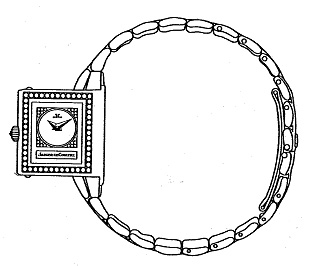TTAB Affirms Refusals to Register the Reversing Motion of a Watchcase
In a time-consuming decision (nearly a year to decide and a day to read), the Board affirmed refusals to register two product design marks (shown below) for watches, on two grounds: (1) Applicant failed to provide an acceptable description of the marks; and (2) the configurations are functional under Section 2(e)(5). In re Richemont Int'l, S.A., Serial Nos. 76413051 and 76413157 (June 22, 2006) [not citable].

In a nutshell, Applicant Richemont was attempting to register "the configuration of a watch as it makes [a] pivoting motion," so that the face of the watch may be placed directly against the wrist, making the back of the watch visible. However, neither Applicant's drawings nor its description of the marks gave "adequate notice of the nature of" applicant's marks: namely, that Applicant claimed as features of the marks the particular movements that are involved in reversing the watchcase. Therefore, the Board affirmed the requirement of an acceptable description of the mark, under Rule 2.37.

In considering the functionality issue, the Board applied the Morton-Norwich factors (In re Morton-Norwich Prods., Inc., 213 USPQ 9, 15-16 (CCPA 1982)) to the feature that Applicant sought to register: "the reversing nature of the watchcase." Faced with a 1933 utility patent that issued to the designer of Applicant's Reverso watch, Applicant conceded that "in, say, 1933, its design was functional," but contended that "intervening changes in watch technology have rendered the design of no significant utilitarian advantage." In particular, the use of "scratch resistant, virtually unbreakable, sapphire glass in the crystals of high quality watches," made the reversible movement no longer needed to protect the watch face.
However, Examining Attorney Nicholas K.D. Altree submitted website and newspaper evidence indicating that "the reversing ability of applicant's watch still protects the watch and thereby retains its utilitarian value."
The Board noted that Applicant did not limit its configuration mark to watches with sapphire glass crystals. Moreover, Applicant "still touts in some of its advertising the protection provided by the reversing nature of the configuration." Given the "heavy burden" on Applicant to rebut the evidence of the utility patent, the Board could not find that the reversing nature of the watch is now non-functional.
Furthermore, the Board could not determine from the record whether sapphire glass crystals would add more to the manufacture of watches than it would cost to incorporate the reversing motion.
In any case, the Board found that the reversing nature of Applicant's watch provides another significant competitive advantage other than protecting the watch face: reversibility allows one to change the appearance of the watch. For example, the watch could have two faces, or it may be reversed to look like a bracelet. Applicant's advertising brochure, as well as third-party articles, stressed that advantage.

As to the availability of alternative designs, Applicant provided only two other reversable watches. Moreover, its own literature refers to the superiority of its design. Thus the three possible watch designs are not "equal alternatives."
Finally, as to cost, the Board could not determine whether the asserted feature is a "result of a cheaper or simpler method of manufacturing the product," and it therefore treated this factor as neutral.
The Board concluded that "[i]f applicant were to obtain exclusive rights to this two-watches-in-one configuration, competitors would be at a significant, non-reputation related disadvantage. It therefore affirmed the refusal under Section 2(e)(5).
Text Copyright John L. Welch 2006.




0 Comments:
Post a Comment
<< Home